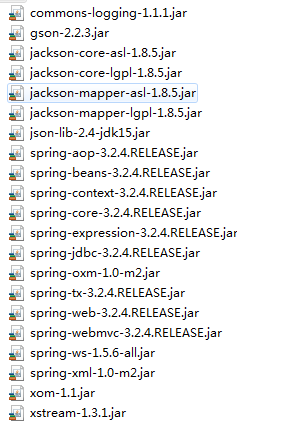SpringMVC简单构造restful, 并返回json——(一)
来源:互联网 发布:mac如何新建word文档 编辑:程序博客网 时间:2024/04/29 15:26
文章要要点:
快速搭建构造restful的StringMvc
GET, POST , PUT , DELETE的各种调用
同一资源 多种表述 (ContentNegotiatingViewResolver解析器),既可以返回对象给JSP, 也可以返回JSON
快速搭建构造restful的StringMvc
首现搭建一个简单的restfulMvc框架, 并上配置文件, 后期会增加带JSON返回值的配置
JAR包

web.xml配置
<servlet> <servlet-name>spring</servlet-name> <servlet-class>org.springframework.web.servlet.DispatcherServlet</servlet-class> <!-- 可以自定义servlet.xml配置文件的位置和名称,默认为WEB-INF目录下,名称为[<servlet-name>]-servlet.xml,如spring-servlet.xml--> <init-param> <param-name>contextConfigLocation</param-name> <param-value>classpath:config/spring-servlet.xml</param-value><!-- 现定义为src下config包里(个人习惯) --> </init-param> <load-on-startup>1</load-on-startup> </servlet> <servlet-mapping> <servlet-name>spring</servlet-name> <url-pattern>/api/*</url-pattern> </servlet-mapping> <!-- Spring配置 --> <listener> <listener-class>org.springframework.web.context.ContextLoaderListener</listener-class> </listener> <!-- 指定Spring Bean的配置文件所在目录。默认配置在WEB-INF目录下 --> <context-param> <param-name>contextConfigLocation</param-name> <param-value>classpath:config/applicationContext-*.xml</param-value> </context-param>spring-servlet.xml配置
<!<beans xmlns="http://www.springframework.org/schema/beans" xmlns:context="http://www.springframework.org/schema/context" xmlns:p="http://www.springframework.org/schema/p" xmlns:mvc="http://www.springframework.org/schema/mvc" xmlns:xsi="http://www.w3.org/2001/XMLSchema-instance" xsi:schemaLocation="http://www.springframework.org/schema/beans http://www.springframework.org/schema/beans/spring-beans-3.0.xsd http://www.springframework.org/schema/context http://www.springframework.org/schema/context/spring-context.xsd http://www.springframework.org/schema/mvc http://www.springframework.org/schema/mvc/spring-mvc-3.0.xsd"> <!-- 启动注解驱动的Spring MVC功能,注册请求url和注解POJO类方法的映射--> <mvc:annotation-driven /> <!-- 启动包扫描功能,以便注册带有@Controller、@Service、@repository、@Component等注解的类成为spring的bean --> <context:component-scan base-package="com.esb" /> <!-- 对模型视图名称的解析,在请求时模型视图名称添加前后缀 --> <bean class="org.springframework.web.servlet.view.InternalResourceViewResolver" p:prefix="/WEB-INF/jsp/" p:suffix=".jsp" /> </beans>applicationContext.xml暂时没写东西
该配置的配置完了,下面就是写第一个HelloWord
package com.dsp.action;import javax.servlet.http.HttpServletRequest;import javax.servlet.http.HttpServletResponse;import org.springframework.context.annotation.Scope;import org.springframework.stereotype.Controller;import org.springframework.web.bind.annotation.RequestMapping;import org.springframework.web.bind.annotation.RequestMethod;@Scope("prototype")@Controller@RequestMapping("/products")public class TestController{ /** * 测试方法,HelloWord * @param request * @param response * @return * @throws Exception */ @RequestMapping(value="/list",method=RequestMethod.GET) public String getProducts(HttpServletRequest request,HttpServletResponse response) throws Exception { request.setAttribute("name", "helloWord"); return "products/list"; }}@Scope("##") : spring默认的Scope是单列模式(singleton),顾名思义,肯定是线程不安全的. 而@Scope("prototype")
可以保证每个请求都会创建一个新的实例, 还有几个参数: session request
@Scope("session")的意思就是,只要用户不退出,实例就一直存在,
request : 就是作用域换成了request
@Controller : 不多做解释 , 标注它为Controller
@RequestMapping :是一个用来处理请求地址映射的注解,可用于类或方法上。用于类上,表示类中的所有响应请求的方法都是 以该地址作为父路径。 比如现在访问getProducts方法的地址就是 :
http://localhost:8080/项目名/上面web.xml配置(api)/products/list
l
暂时先介绍两个属性 value和method
具体可以参考我参考的文章 http://blog.sina.com.cn/s/blog_72827fb10101pl9i.html
value: 就是映射的实际地址,这个上面有说过, 而重要的是里面的值 , 有几个比较感兴趣的
1. 正常的 /list 访问地址类似 http://localhost:8080/项目名/api/products/list
2. 带参数的 /info/{proId} 访问地址类似 http://localhost:8080/项目名/api/products/info/0001
method: 请求的method类型 GET POST PUT DELETE等
好,做个测试 JSP代码:
<%@ page language="java" contentType="text/html; charset=UTF-8" pageEncoding="UTF-8"%><!DOCTYPE html PUBLIC "-//W3C//DTD HTML 4.01 Transitional//EN" "http://www.w3.org/TR/html4/loose.dtd"><html><head><meta http-equiv="Content-Type" content="text/html; charset=UTF-8"><title> 你好</title></head><body>${name }</body></html>地址栏输入 http://localhost:8080/RestFulMvc/api/products/list
得到结果

GET, POST , PUT , DELETE的各种调用
刚才写的是第一种GET, 第二种GET:
@RequestMapping(value="/info/{proId}",method=RequestMethod.GET) public String getProductInfo(@PathVariable String proId, HttpServletRequest request,HttpServletResponse response) throws Exception { request.setAttribute("name", proId); return "products/list"; }@PathVariable注解获取的就是大括号里的值
测试 : 输入地址 http://localhost:8080/RestFulMvc/api/products/info/00001
测试结果为

如果不用@PathVariable接收大括号里的值,也可以用bean来接收:
public String getProductInfo(Product pro, HttpServletRequest request,HttpServletResponse response)...
而且也可以设置多个参数
@RequestMapping(value="/info/{pid}/{pname}",method=RequestMethod.GET)
让我们看下面这段代码
@RequestMapping(value="/info/{pid}/{pname}",method=RequestMethod.GET) public String getProductInfo(Product pro, HttpServletRequest request,HttpServletResponse response) throws Exception { request.setAttribute("name", pro.getPid()+"___"+pro.getPname()); return "products/list"; }访问地址: http://localhost:8080/RestFulMvc/api/products/info/00001/23123
得到的结果为 :

- SpringMVC简单构造restful, 并返回json——(一)
- SpringMVC简单构造restful, 并返回json
- SpringMVC简单构造restful, 并返回json
- SpringMVC简单构造restful, 并返回json
- SpringMVC简单构造restful, 并返回json
- SpringMVC简单构造restful, 并返回json
- SpringMVC简单构造restful, 并返回json
- springmvc搭建返回json格式的restful api
- 通过gradle生成SpringMVC实现RESTful返回JSON格式数据
- springmvc 构造restful
- Springmvc构造RESTful讲解
- springmvc学习笔记(26)——返回JSON
- SpringMVC RESTful Json Example
- springmvc-restful-json
- SpringMVC学习总结(2)——SpringMVC返回json配置
- JSONModel简介(一)——读取并转化简单的本地JSON文件
- SpringMVC简单构建RESTful
- Springmvc构造RESTful详细讲解
- javascript开发与调试方法
- Linux下随机10字符病毒的清除
- 题目:k数和 II
- HDU 1015 Safecracker(DFS搜索)
- MYSQL5.X重置root密码 (windows系统)
- SpringMVC简单构造restful, 并返回json——(一)
- 题目:Maximal Square
- UVALive - 5906 Smoking gun(差分约束系统+拓扑排序)
- android ListView向上滑动隐藏标题,下拉显示标题栏
- 题目:nuts 和 bolts 的问题
- 将要和正在读的软件架构书
- Android开发菜鸟到高手必备的十本畅销书籍
- 互联网创业公司的产品该怎么做?
- 黑马程序员05面向对象特征之封装


